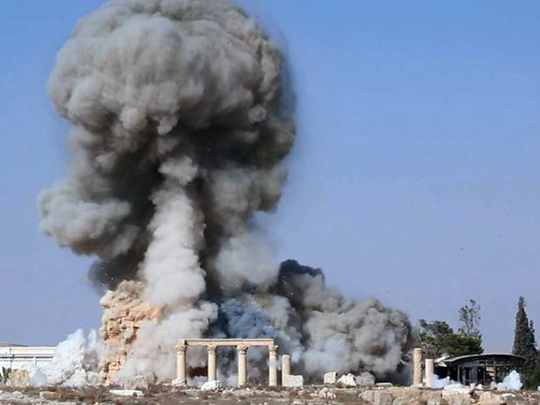
Since capturing Palmyra last May, Daesh (the self-proclaimed Islamic State of Iraq and the Levant) has blown up at least two ancient temples, Bel and Baalshamin, and more recently demolished the iconic Arch of Triumph — an 1,800-year-old monument that opened into Palmyra’s elegant Colonnade. They have also destroyed a Roman-era tower and the statue of a lion at the gates of Palmyra’s Museum. Daesh has also demolished the tomb of Mohammad Bin Ali, a grandson of the Prophet (PBUH), located in a hilly area 4km north of Palmyra.
As the world focuses on Daesh’s systematic destruction of Palmyra, however, antiquity dealers are seemingly busy smuggling historical artefacts out of the fabled city and others under its control. Among other things, Daesh claims to be in possession of an ancient Shiite scripture, stolen from Baghdad and smuggled to Mosul. It is now on sale for more than $100 million (Dh3.67 million). If the manuscript on sale is proven authentic, however, it would be a major triumph for Daesh. Not only would it give us a glimpse of what kind of treasures are held by the group, but also, what kind of money is going to find its way into its coffers, stolen from Mosul, Al Raqqa and the ancient Syrian desert city of Palmyra, northeast of Damascus.
Daesh has already generated plenty of revenue from the excavation and sale of gold coins, bronze artefacts and early Christian relics such as gold chalices. Statues, crucifixes, Byzantine coins and iconography are, however, immediately destroyed, no matter their worth, since making money from them is ‘haram’ (prohibited by religion). Daesh, for example, looted the ancient Assyrian city of Dur Sharrukin in northern Iraq, selling most of its treasure, but it demolished the city of Hatra and bulldozed Nimrud, south of Mosul. Daesh justifies the sale by saying that such artefacts are alien to Islamic culture and need to be removed in order to purify the Islamic state. Reportedly, it made $36 million from selling stolen artefacts from Al Nabk, north of Damascus, in 2014.
Not all of the stolen material is found in Daesh territory. Some of the findings that have been shipped to Daesh for sale include boxes of pure gold Ottoman coins, found in Damascus and near the Daraa station in southern Syria. The gold boxes were buried by Ottoman officers fleeing Damascus at the end of the First World War. Depending upon the quantity, gold is sold at $5,000–$10,000 per box, according to one artefact trader. Last May, Daesh tried to set up a Ministry of Antiquities. The task was not to protect the treasures, but to maintain an inventory and calculate their worth, to facilitate the sale of looted artefacts.
Daesh is rich. Unlike Al Qaida, which relied on donations from members and sympathisers, Daesh earns its own money. Thanks to the oil fields under its control, Daesh has collected tens of millions of dollars in less than a year. In total, they control 11 oilfields in Syria and Iraq, including Al Omar, with a production capacity of 75,000 barrels per day. They have produced crude oil from captured fields and according to a US treasury official, they earn $1 million per day from the export of oil. Much of it is sold illegally to whoever is willing to buy. Daesh oil production currently stands at approximately 90,000 barrels per day. Daesh is still pushing to control more oil fields in the Syrian Desert and Al Anbar province in Iraq. Daesh is also eyeing the Jazal oil field near Palmyra in Syria and the Baiji oil refinery in Iraq.
The self-proclaimed ‘caliph’ Abu Bakr Al Baghdadi takes salaries, pensions and funds very seriously. He insists that his men be paid on time, although he himself gets no salary for heading Daesh. He is taken care of by his loyal flock.
According to an Iraqi intelligence report, Daesh had assets worth $2 billion. Many of these assets were confiscated property in Al Raqqa and Mosul. After sweeping Mosul, Iraq’s second largest city, for example, Daesh seized $420 million in cash from the coffers of the city’s Central Bank. Daesh has also enforced its own shadow taxation on cargo coming through the Syrian-Iraqi border. It currently stands at $300 for trucks carrying fruit and vegetables, and $400 a truck for electronics goods (LCD screens, air-conditioners, refrigerators and cellular phones). Patrols monitor these trucks, ostensibly to protect them from bandits, and give them receipts to display at Daesh checkpoints.
Nobody can tell for sure what Daesh’s monthly expenditures have been, because nobody knows exactly how many people are on its payroll. What we do know is that Daesh salaries are always paid in cash. All banks — even Islamic ones — are prohibited in Daesh culture. We also cannot tell for sure how much money they have in their treasury. According to Michael Knights, a Middle East expert at the Washington Institute for Near East Policy, Daesh is the “world’s richest terrorist organisation” leading “the world’s poorest state”.
If they now possess ancient manuscripts as well, their terrorists are likely to become richer in the months ahead — if they are able to find antique dealers willing to buy those.
Sami Moubayed is a Syrian historian and author of Under the Black Flag: At the frontiers of the New Jihad (IB Tauris, 2015)










